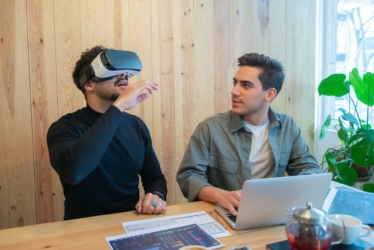Insights
Advanced: Digital Conferences 2020 and beyond
This year has been full of digital transformations all over the globe. Digital conferences have emerged prominently as key sites of professional and academic engagement. Earlier this year we published our initial findings on how to approach an online conference. Now that the dust has settled (a bit) and best practices are taking shape, we’re back to help you improve digital conferences. For avid social media users, much of what follows was captured in a recent Twitter thread.
Positive Benefits: Sustainability & Diversity
As expected, the CO2 footprint of conferences has greatly reduced since going online in 2020. This is mostly due to zero airmiles associated with virtual gatherings. For instance, Leiden University astronomers found that face-to-face conferences consume 3,000 times more carbon emissions than an online forum.
There is also an increase in the number of participants, partly because of greater accessibility and partly because of lower costs. The diversity of these participants has increased as well, drawing in more women, PhDs, and people from non-Western countries.
Still missing: Social Life and Concentration
Many of the online formats are struggling to incorporate the social aspects of conferences into virtual meetings. Participants miss interaction, networking, and cultural exchange opportunities. Moreover being online constantly lowers our ability to concentrate, sometimes called zoomfatigue. This is caused by our brains trying to pay attention to many different channels of information, including incomplete non-verbal communication clues.
Deliberate design to solve ongoing problems
So how do we restore the social aspect of conferencing after going virtual? As always with anything virtual you should make a deliberate effort to recreate the real (or in-person) thing. Look closely at your event and determine what are the social elements you need to bring the digital conference. Are there informal moments that you can somehow recreate? Are there things that might trigger curiosity to draw people in?
It has been suggested that a more blended format in future might solve this issue. For instance, meeting in regional hubs that can be reached by train or other forms of accessible transport might well solve this very human need for contact. Take a leaf from the book of online communities and think of:
- A chatroom or forum as a social layer around your conference, where participants can introduce themselves and find likeminded people. It helps to have a host there.
- Making sure you encourage interaction between participants/the audience, for instance by using online polls, or giving themes to the rooms.
- Allow people to express their personality/identity, not just using a profile picture (or an avatar) and bio, but things like colours and signatures. Be aware of data privacy, and do not force people to give out information they are not comfortable sharing.
- Host pre-event meetings (these come with the added bonus people can check they have all their tech in order to join the conference)
- Ensure you have a moderator in chat who can filter questions to the host, but also nurture connections between people.
Other very practical tips:
- Combat zoom fatigue by regular breaks in the programme once an hour and don’t make something that takes longer than 3 hours in a day. It is better to spread your event over several days.
- Add a cultural touch. Add pictures, or a filmed walk around the local area. Give participants a sense of what it is like to be there.
- Change work formats (more often than you would in a physical meeting) – this will keep people active.
- You can reduce risk with the keynote speaker by letting them tape their main talk beforehand, and have them available for a Q&A afterwards.
- Check the time zones of your target audience. You might want to draw an international crowd and not everybody is willing to stay up late or wake in the middle of the night to attend.
Platform Advice – Leiden University
In Leiden you have two university systems that are suitable for conferences:
<300 participants: MS Teams
>300 (up to 10.000)MS Live Events
You can ask ISSC for technical support. Direct your organisational support questions to your teacher support desk or your communication department. Remember these are also accessible to support staff.
Of course, you can also choose another platform against a more commercial price, but be aware of GDPR rules in your contract and check with your data protection officer of your faculty. Most professional companies offering webinars approach these events as a TV talk show production.
Other Resources
- https://www.leidenlearninginnovation.org/stories/top-tips-for-remote-conferencing/
- https://www.lorentzcenter.nl/virtual-workshops.html
- https://leidenmadtrics.nl/articles/pre-covid-19-workshop-on-virtual-meetings-and-conferences
- https://www.staff.universiteitleiden.nl/vr/video-toolkit?cf=service-units&cd=administration-and-central-services
- https://threadreaderapp.com/thread/1306996112381935618.html
More Support
The Centre for Innovation can provide learning design sessions to help you structure your conference for the best learning and engagement outcomes. We do not currently provide technical or organisational support for remote conferencing, but in a design session can advise on the expertise needed to ensure you have the right support. If you are interested in such a session, please contact us via c4i@sea.leidenuniv.nl.
Get in touch with the author

Tanja de Bie
Online Learning Expert
t.de.bie@sea.leidenuniv.nl




